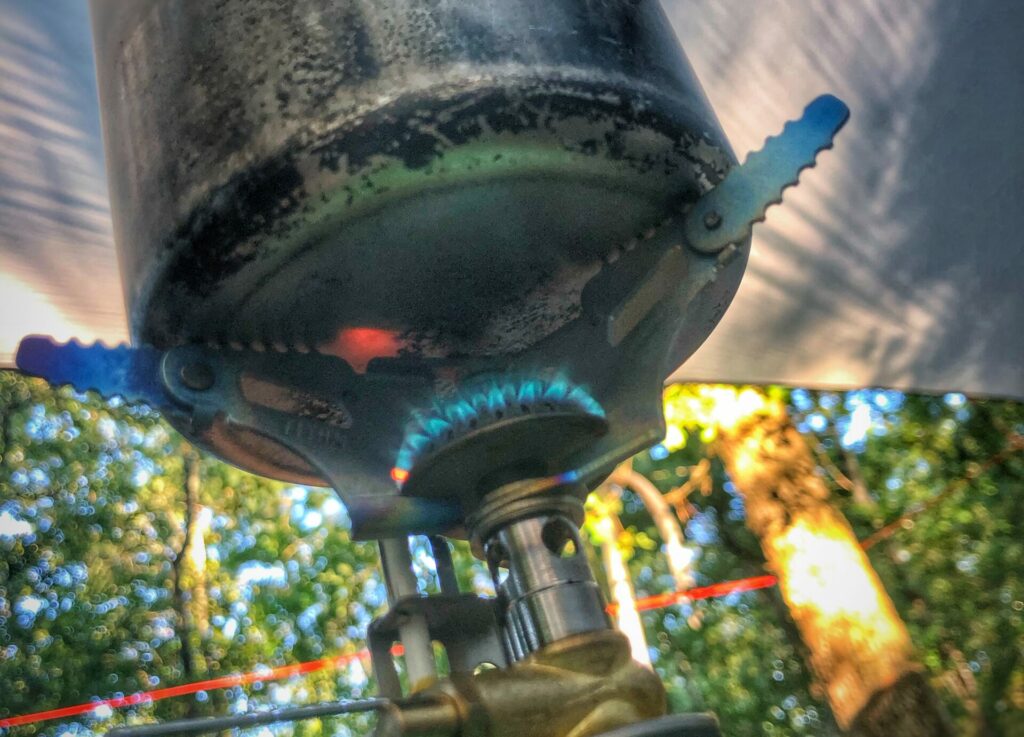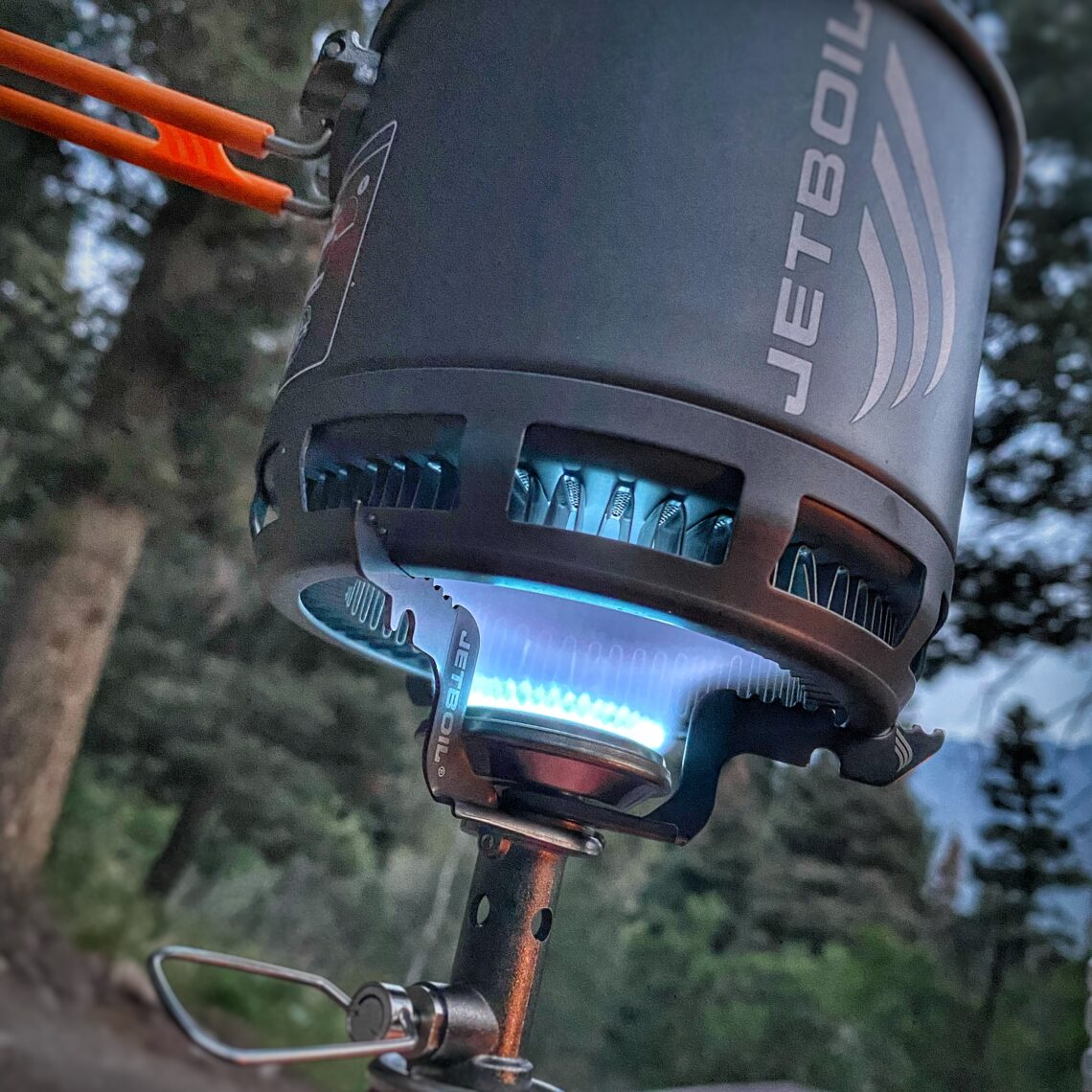Though I have often picked up Jetboil systems and turned them over in my hands at outdoor stores and put them into online shopping carts several times, I could never seem to pull the trigger on one. Until now. For me, JetBoils were just too clunky, too heavy, and too narrow in application to earn a spot in my pack. And that permanent pot cozy just looked like the big top for a germ circus to me. Never mind that all of that neoprene and colorful plastic makes it look more at home surf-side filled with some fancy $10 smoothie, or maybe a bubble tea with one of those straws that looks more the proportion of a feeding tube.
I like simple stuff that just works, without a lot of fuss. And when I find it, I keep it for the long haul. For nearly 20 years, I’ve used an old Markill (no longer in business) Peak Igniter Titanium folding canister stove and a Snow Peak Ti-Mini Solo Combo (the version I have is discontinued so this link is to 2.0). And other than being relatively slow to boil and somewhat susceptible to wind, that little stove has worked like a champ. Especially when I use my sit pad as windscreen like in the pic below. Even the piezo igniter still works. The only change I make, sometimes, is that I’ve started subbing in a Toaks Light Titanium 650ml Pot for the Snow Peak set to shave weight and mass in my pack.

Over the years, new backpacking canister stoves and concepts have come and gone. I mean, the basic technology of the camp stove has changed little over the decades. The fuel sources vary—from isobutane to alcohol to biofuels. And the flames have gone from an easy bloom to an outright blowtorch trying to shave seconds off of that boiling time. But, essentially, they all put a fire under a pot to boil water or cook food. In the case of backpacking stoves, it’s mainly the former. And for the most part, the improvements that have come along over the years have been incremental. I’ve been mildly intrigued by a few offerings, but it was going to take more than a passing fancy to see me change course.
Enter Jetboil. Founded in 2001, it debuted its first products in 2003 at the Outdoor Retailers Trade Show. The MiniMo cook system was its first offering and represented 3 major innovations in backcountry camping stoves. First of all, it was sold as a system—a stove and cup/pot that locked together. The aluminum cup/pot also came with an insulating sleeve. But the real innovation was evident when you turned that vessel over to see the “fluxring” circling the bottom. It’s well known that a bigger pot with more surface area on the bottom boils water faster, but who wants to carry a big pot in their pack to boil water for 1 or 2 hikers? The fluxring was an attempt to “fold up” that surface area and weld it to the bottom of a smaller pot, creating a more efficient heat exchanger. And it worked. But the performance technology just couldn’t overcome the form factor enough to win me over.
For me, traditional Jetboil systems were just too clunky, too heavy, and too narrow in application to earn a spot in my pack. And that permanent pot cozy just
looked like the big top for a germ circus to me.
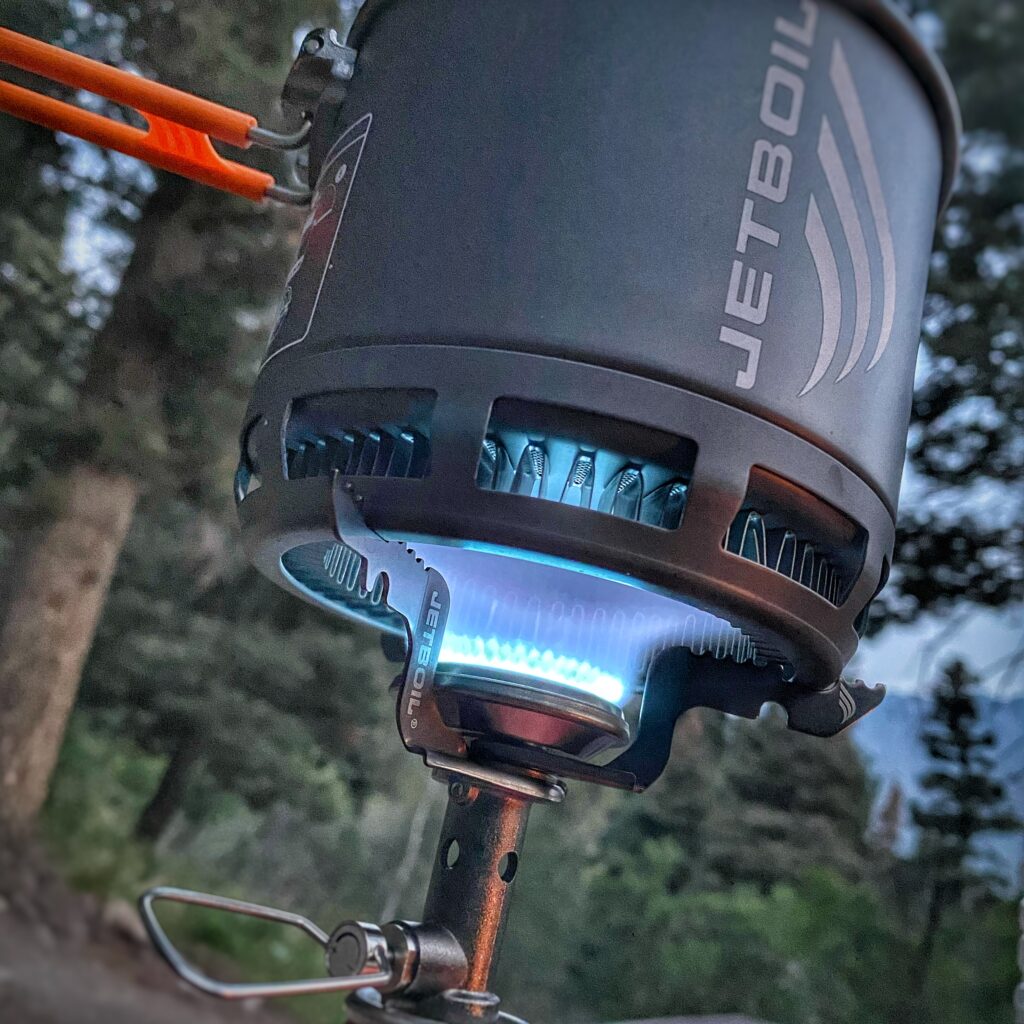
But that changed earlier this year with the release of the Jetboil Stash Cook Kit. The system includes an aluminum .8 liter pot with flux ring (and no nasty pot cozy), a fuel canister stand, a canister stove in a cute little bag so it doesn’t beat up your pot, and a plastic lid that holds a 100gm fuel can upside down with enough room to nest a mini bic lighter (which you’re going to need as the stove has no igniter). And while it has enough logos and garish lettering on it to give Times Square a run for its money, at least it looks and feels like a legitimate camping cook pot.
First, let me talk about what I don’t love about the system. Hate, actually. It’s heavier than what I carry now. The complete kit (sans fuel) is 7.4 oz, which is an additional ounce when compared to my current setup. I miss the ease of the igniter on my Markill, but don’t count the lighter in the Jetboil kit weight because I carry one in my pack already. It’s also bulkier than my former kit. The pot is a little higher capacity and built a little shorter and wider. That makes finding a nook for it in my pack a little more challenging.
JETBOIL STASH QUICK SPECS:
Weight: 7.4 oz, 210g
Capacity: 0.8 L
BTU: 4,500
Boil Time: 2:30 for 1 L
Fuel Efficiency: 12 L boiled / 100g Fuel
Pressure Regulator: Yes
Built-in Ignition: No
Storage Bag: No
All of the components nest handily in the pot, but there is only one way they can really fit so until you get the hang of it, it’s like playing a puzzle game every time you pack it up. Not my favorite thing when I just want to break camp quickly and get back on the trail to make some miles or down to the river to dance with some trout. JetBoil must have anticipated the added pain as they printed actual pack-up instructions on the pot and even positioning diagrams on the stove sack for how and where it must be placed.
Speaking of storage sacks, this kit doesn’t come with one, which I find pretty stingy when it retails for 129 bucks. Finally, I prefer titanium to aluminum for its strength, durability, and “feel.” I’m not rough on my gear, but I don’t baby it either and after 6 months in and out of my pack and van camping kitchen kit, I already have a bend in the bottom metal that shields the flux ring (see pic) that I attempted to bend back with my Leatherman multitool.
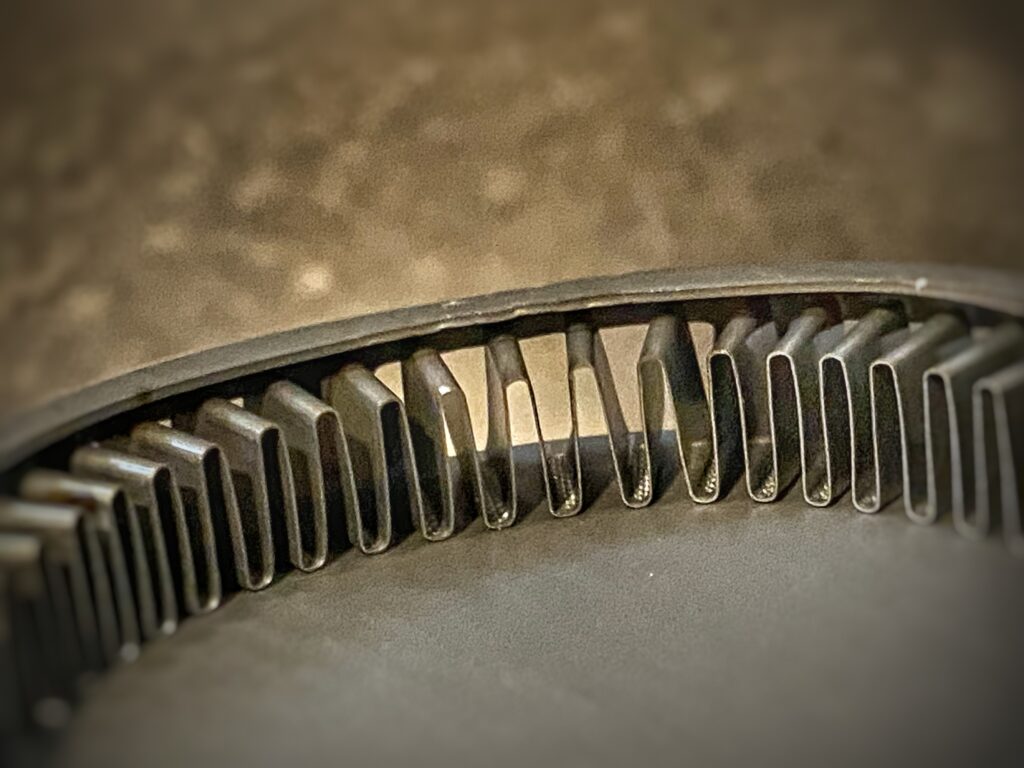
So why do I use it despite all that’s not to like? There’s really just one reason. Efficiency. And unfortunately for me, this reason alone is compelling enough to drown out my cacophony of complaints about the Stash. I can boil water for my 2-serving dehydrated meal in 2.5 minutes. Even less for coffee/tea water. This is especially noticeable when I want to make a hot lunch on a longer day hike. I would often forgo the luxury in that scenario because it already takes 20 minutes for most backpacking meals to rehydrate, and I didn’t want to have to wait several minutes more for the water to boil. Unless it’s an out and back trail with a lovely vista as the destination, an hour for a day hike lunch stop is a lifetime. It’s even forced me to adjust my routine at camp. I went from having several minutes to prep my fire lay while the water boiled for dinner to having barely time to scramble getting the meal bag prepped before the water boiled over.
So why do I use it despite all that’s not to like?
There’s really just one reason. Efficiency.
And unfortunately for me, this one reason is compelling enough to drown out my cacophony of complaints
about the Jetboil Stash.
And that efficiency is about more than just saving time at camp or on the trail. It’s also about saving money, weight, and hassle as well. How? Well, over the life of a camp cooking system that will be in service for several years, fuel is the biggest cost. And I can boil 12 liters with one 100g canister. That’s nearly twice as much water as the 6.4 liters I can get out of my old system. And that also translates into 2-3 extra trail days on one canister meaning that there is no need to carry a spare. So, about half the cost and half the weight in fuel. Cool.
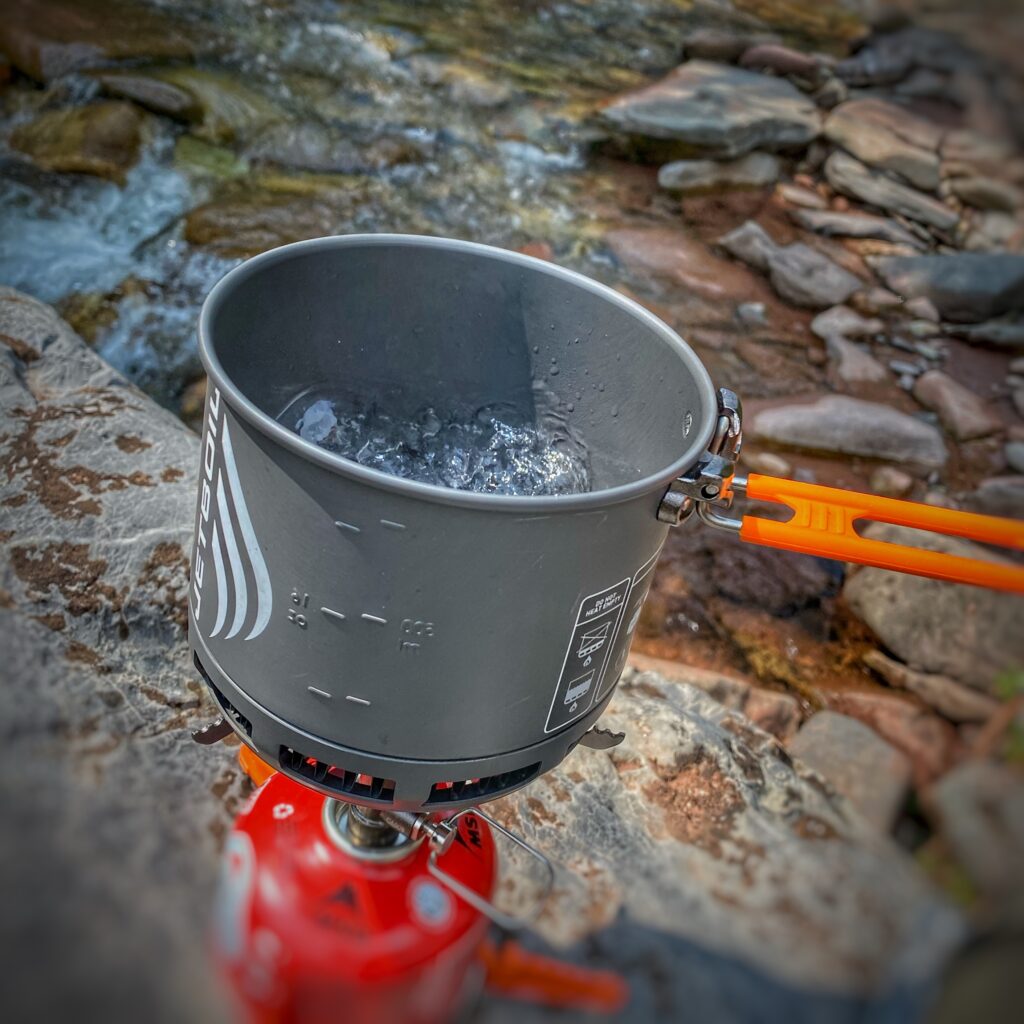
There are a couple other things about the system that I don’t hate. Like the fold-over, silicon-covered pot handle that secures the lid in transit and locks convincingly into place to offer your hand a solid purchase on the container when in use. I also like that the titanium stove arms, which are nice and long for an ultralight stove, have notches in them that fit the flux ring perfectly and keep it from sliding about. This is particularly helpful, and a lot safer, when uneven ground makes it virtually impossible for a level set up. I first thought the little plastic fuel canister stand would be wasted weight, but have found it quite handy, especially since the wider, higher-capacity pot makes for a pretty top-heavy contraption on a 100-gram fuel can. Finally, this system is actually decent at simmering, which can’t be said of most boil-at-the-speed-of-light rocket stoves.
Has Jetboil made the ultimate backpacking set up for those wanting a flexible system that balances weight and efficiency? Maybe. Have they finally made a system that has put their tech in a small and light enough package to lure me away from my trusty, beat-up old friend of a kit? Yup. But don’t think the old Markill has seen its last trail or made its last cup of coffee. Slow and steady still has its place in the race, and that little hottie will always be my first flame.
